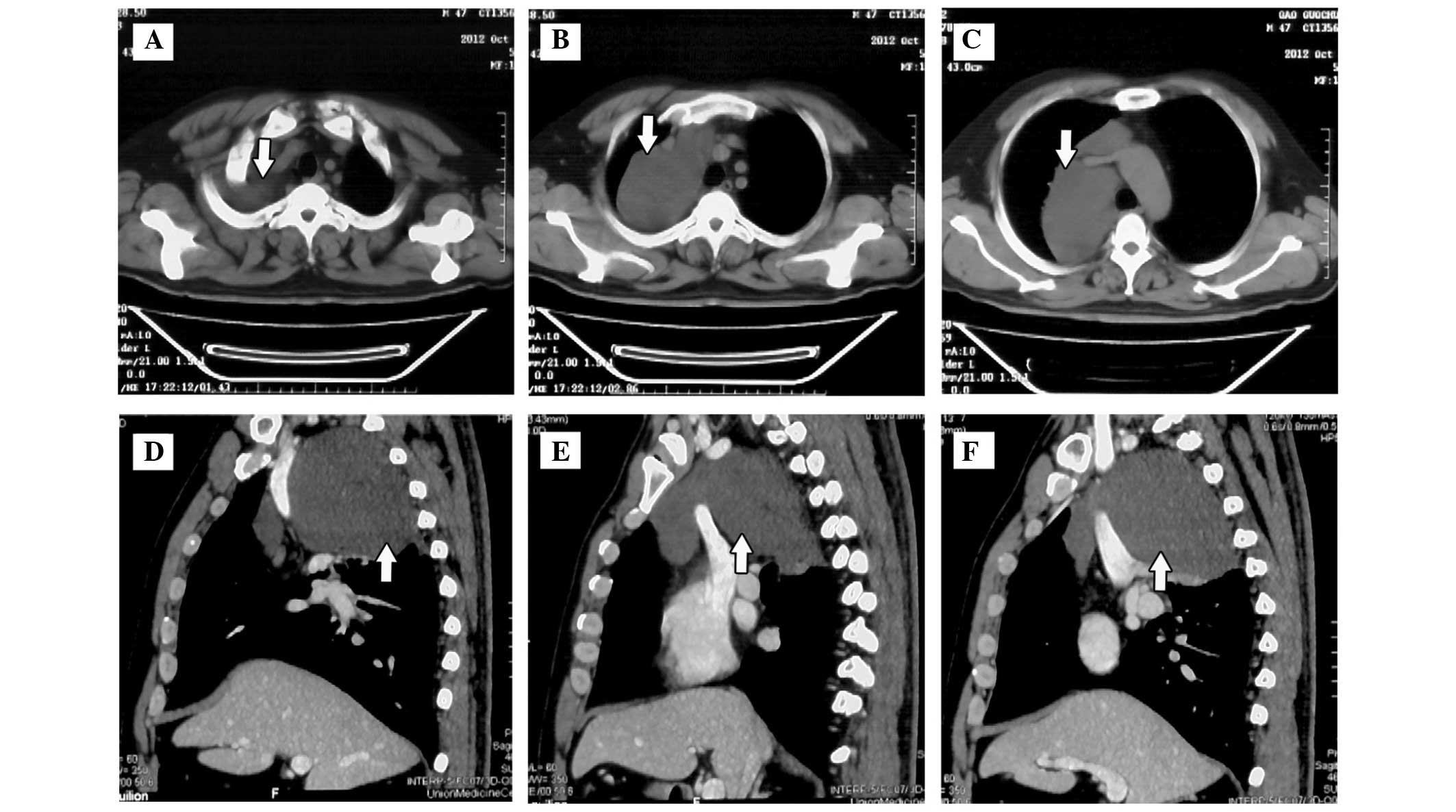Giant primary cystic mediastinal lymphangioma: A case report
- Authors:
- Published online on: July 4, 2014 https://doi.org/10.3892/ol.2014.2320
- Pages: 1246-1248
Abstract
Introduction
Cystic lymphangioma, also known as cystic hygroma, is a congenital malformation originating from lymphatic hyperplasia. Cystic lymphangioma is a type of hamartoma and verges on the clinical boundary between tumor and deformity. The majority of lymphangiomas are observed in patients under the age of five (1), with extremely few cases reported in adulthood. This disease can occur in various areas of the body, with the most common location being the neck. Usually, the tumors are slow-growing, with an asymptomatic clinical course. Cystic lymphangiomas are commonly soft and painless masses, but cannot easily be compressed.
Cystic mediastinal lymphangioma (CML) is an extremely uncommon benign cystic lymphangioma developed from the lymphatic vessels. With regard to cystic lymphangioma, only ~1% are mediastinal (2). CMLs are most often located in the anterior mediastinum. In order to improve the diagnosis and treatment of CML in clinical practice, knowledge on the topic must be compiled and shared. The present study reports the case of a giant anterior CML for this purpose. Patient provided written informed consent.
Case report
A 46-year-old, male, non-smoker was diagnosed with a right anterior mediastinal tumor by computed tomography (CT) scan during a physical examination in October 2012 (Fig. 1). No significant previous medical history was reported and no specific clinical manifestations. Examinations performed prior to surgery included test of pulmonary function and narrow band imaging bronchoscopy, and no abnormal findings were observed. The results of the analysis for tuberculosis (TB) antibody and TB-DNA in the serum were all negative. Serum tumor markers for lung carcinoma, including carcinoembryonic antigen, carbohydrate antigen-125 (CA-125), squamous cell carcinoma (SCC), CA72-4, cytokeratin 19 fragments, neuron-specific enolase and ferritin were all within the normal ranges. The initial tentative diagnosis was of a thymoma or bronchocele.
Subsequently, the lung resection of the mediastinal tumor was performed by video-assisted thoracoscopy. A cystic and globose tumor, with the largest diameter of 18.0 cm, was located in the lateral section of the right anterior mediastinum (Fig. 2A). Following separation of the cyst wall from the base, the cystic wall was removed (Fig. 2B). During the surgery, ~400 ml of pale yellow liquid was absorbed from the cystic cavity (Fig. 2C). Following resection of the cystic wall and hematoxylin-eosin staining, the histopathology was observed under a light microscope (Nikon Eclipse 80i; Nikon, Tokyo, Japan). The postoperative pathological examination of the cystic wall showed multilocular cystic cavity in the cystic wall, surrounded by smooth muscle and lymphoid tissue, as well as the neoplasm. As a result, a diagnosis of CML was determined (Fig. 3). At the one-year follow-up there were no signs of recurrence.
Discussion
Mainly occurring in childhood, cystic lymphangiomas are extremely rare, with 90% being diagnosed prior to two years of age. A limited number of studies exist with regard to cystic lymphangioma in adults (3). CML is an extremely rare vascular tumor originating from the lymphatic vessels. In total, <1% of cystic lymphangiomas occur in the mediastinum and >90% are discovered in individuals under two years old (4). CML is benign and is usually an incidental finding unless there are symptoms caused by compression of local tissues and structures or infection. The CT images of CML often resemble adenopathy or a mass. For adult patients, the probable diagnosis would be of a thymoma, bronchocele or malignancy.
Complete resection may be difficult in certain cases due to their proximity to vital structures in the mediastinum (5). Although other treatment methods, such as sclerotherapy and radiotherapy, have been reported in unresectable cases, they are generally ineffective and may result in hemorrhage and infection (6). Therefore, surgery remains the superior method for treatment with curative intent. Complete surgical resection remains the treatment of choice for lymphangioma in order to eliminate symptoms and prevent recurrences (7). The risk of tumor recurrence due to an incomplete excision ranges between 0 and 13.6%, while the aspiration of cystic fluid only decreases cyst size for a short time and introduces the patient to the risk of infection (8). Currently, there are few documented cases of giant CML (9–11). In the present study, the largest diameter of the CML was 18.0 cm and the volume removed from the cystic cavity during surgery was ~400 ml. Histological analysis, the gold standard method, was able to confirm the CML diagnosis.
In summary, CML, particularly giant CML, is extremely rare in adults. Complete surgical resection provides a definitive histological diagnosis and prevents recurrence.












